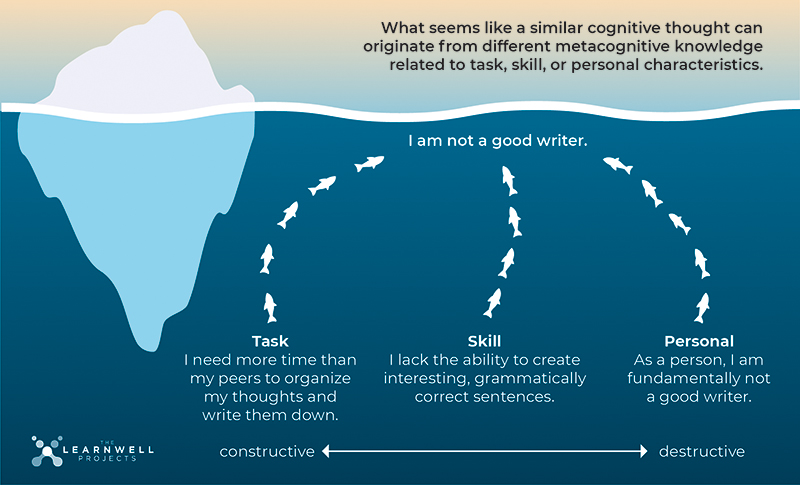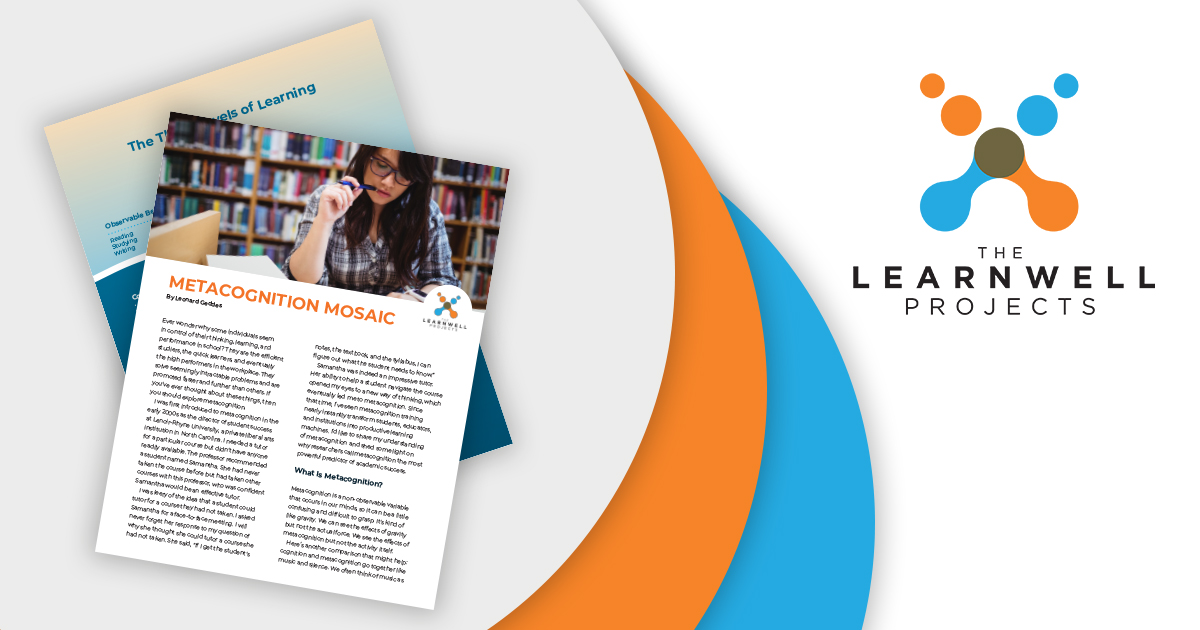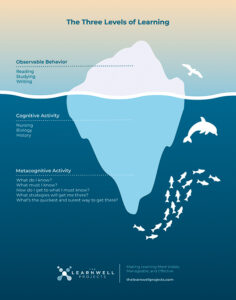Click on the clip to view the full video on YouTube.
I was first introduced to metacognition in the early 2000s as the director of student success at Lenoir‑Rhyne University, a private liberal arts institution in North Carolina. I needed a tutor for a particular course but didn’t have anyone readily available. The professor recommended a student named Samantha. She had never taken the course before but had taken other courses with this professor, who was confident Samantha would be an effective tutor.
I was leery of the idea that a student could tutor for a course they had not taken. I asked Samantha for a face‑to‑face meeting. I will never forget her response to my question of why she thought she could tutor a course she had not taken. She said, “If I get the student’s notes, the textbook, and the syllabus, I can figure out what the student needs to know.”
Samantha was indeed an impressive tutor. Her ability to help a student navigate the course opened my eyes to a new way of thinking, which eventually led me to metacognition. Since that time, I’ve seen metacognition training nearly instantly transform students, educators, and institutions into productive learning machines. I’d like to share my understanding of metacognition and shed some light on why researchers call metacognition the most powerful predictor of academic success.
Here’s another comparison that might help: cognition and metacognition go together like music and silence. We often think of music as the harmonic sounds that we hear when it’s playing. Those sounds capture our attention and can be characterized and described. But silence also plays a major role in music. The silence (or “rests” in musical terms) interspersed between the sounds determines the rhythm. So sound and silence work together to produce music. Cognition and metacognition work together in a similar way.
Researchers define cognition as the mental activity and process of acquiring knowledge through the application of thought experience, and metacognition as the mental activity that informs and directs explicit cognitive thinking. A broad range of interpretations of metacognition can be found in cognitive psychology and science literature, but they generally boil down to an individual’s active participation in his or her thinking processes. So metacognition dictates cognition.
Think of learning as having three levels: the content exists on the most surface level of students’ cognition; how they think about the content sits just below the surface; and metacognition flows from the deepest level. Metacognition is the most formative part of students’ mental work, forming the roots of success and performance. It creates the environment for how students will think, how they will interpret discreet academic experiences, and how they will use their cognitive resources throughout their learning process.
The four components of metacognition include knowledge, experience, awareness, and skill, which we’ll explore further in this article. We’ll cover the metacognitive knowledge in this post and cover the rest in the next post.
Metacognitive knowledge or meta-knowledge is knowledge about one’s thinking, thinking processes, mental states, dispositions, and so forth. Our meta-knowledge exists in three forms: declarative (what), procedural (how), and conditional (when and why).
Declarative knowledge tells us what to do. It refers to the factual information about our thinking, ourselves as learners, and factors that influence our performance we can retrieve from memory. For example, a student named Juanita knows that she needs to write out each step in mathematical formulas, which is knowledge about herself as a learner. She also knows that she works best in the mornings, which is knowledge about factors that influence her performance. Both of these pieces of meta-knowledge are active assets in her declarative knowledge base.
Procedural knowledge tells us how to do something. The steps and processes Juanita uses to solve mathematical problems are part of her procedural knowledge.
Conditional knowledge refers to when and why to use procedures, skills, or strategies. Juanita recognizes that problem sets in her chemical engineering class require her to use formulas she learned in calculus. This is evidence of her conditional knowledge at work. She knows the conditions under which to use calculus to solve a problem in a non‑calculus course.
When people refer to students’ metacognitive knowledge, they’re usually referring to their declarative knowledge. Students’ metacognitive knowledge shapes how they think and feel while doing academic work and how they think and feel about themselves as academic agents, and it functions as a filter for how they view challenges. All of these factors occur subconsciously within students, but they directly affect the conscious decisions students make while doing academic work.

Darren decides to skip this and any future writing assignments in this or his other courses. He subconsciously attributes his belief that he’s not a good writer to a lack of writing skills, and his metacognitive knowledge informs him that nothing can help him improve. So he uses a psychological face‑saving strategy of avoidance to escape the pain of failure. Darren’s metacognitive conditions have led him to attribute his challenge to a lack of skill, which leads to a more destructive decision than Jamal.
Liz is so frustrated by the writing assignment that she is considering withdrawing from school. She attributes her belief that she is not a good writer to a personal characteristic. Liz attributes her struggles to herself as a person rather than confining them to a specific task or skill. She further believes that this personal characteristic means she is not cut out for college. This is another, more extreme example of the destructive effect of bad metacognitive knowledge.
It’s important for us to grasp that while Jamal, Darren and Liz are making conscious, cognitive‑level decisions, they are unaware of the metacognitive knowledge that is informing their decisions. If you’re familiar with popular topics such as grit, growth mindset, self‑efficacy, self‑reliance, locus of control, and so forth, you can likely see how metacognition is a precursor to and interacts with each of those constructs.

See you in the comments!
Bibliography
Batha, K., Carroll, M. (2007). Metacognitive training aids decision making. Australian Journal of Psychology, 59(2), pp. 64–69.
Coutinho, S.A., Neuman, G. (2008). A model of metacognition, achievement goal orientation, learning style and self‑efficacy. Learning Environments Research, 11(2).
Eccles, J. S., Wigfield, A., & Schiefele, U. (1998). Motivation to succeed. In W. Damon &
N. Eisenberg (Ed.), Handbook of child psychology: Social, emotional, and personality development (p. 1017–1095). John Wiley & Sons, Inc.
Flavell, J.H. (1979). Metacognition and cognitive monitoring: A new area of cognitive‑ development inquiry. American Psychologist, 24(10), pp. 906–911.
Hall, C.W., & Webster, R.E. (2008). Metacognitive and affective factors of college students with and without learning disabilities. Journal of Postsecondary Education and Disability, 21(1),
pp. 32–41.
Hall, N.C., Hladkyj, S., Perry, R.P., & Ruthig, J.C. (2004). The role of attributional retraining and elaborative learning in college students’ academic development. The Journal of Social Psychology, 144(6), pp. 591–612.
Halpern, D.F. (1998). Teaching critical thinking across domains: dispositions, skills, structure training, and metacognitive monitoring.
American Psychologist, 53(4), pp. 449–455.
Hargrave, A., Ryan, Nietfeld, L., John (2015). Learning, Instruction, Cognition. The Journal of Experimental Education, 83(3), 291–318
Hennessey, M.G. (1999). Probing the dimensions of metacognition: Implications for conceptual change teaching‑learning. Paper presented at the annual meeting of the National Association for Research in Science Teaching, Boston, MA.
Kelemen, W.L. (2000). Metamemory cues and monitoring accuracy: Judging what you know and what you will now. Journal of Educational Psychology, 98(4) pp. 800–810.
Kuhn, D., & Dean, D. (2004). A bridge between cognitive psychology and educational practice. Theory into Practice, 43(4), pp. 268– 273.
Mango, C. (2009). The role of metacognitive skills in developing critical thinking. Metacognition Learning, 5, pp. 137–156.
Mussweiler, T. (2003). Comparison processes in social judgment: mechanisms and consequences. Psychological Review, 110(3),
pp. 427.
Schraw, G., & Dennison, R. S. (1994). Assessing metacognitive awareness. Contemporary Educational Psychology, 19, pp. 460–475.
Scheibe, K.K., Mennecke, B.M., & Luse, A.A. (2007). The role of effective modeling in the development of self‑efficacy: the case of the transparent engine. Decision Science Journal of Innovative Education, 5(1), pp. 21–42
Taylor, S. (1999). Better learning through better thinking: Developing students’ metacognitive abilities. Journal of College Reading and Learning, 34–45.
Young, A., & Fry, J. (2012). Metacognitive awareness and academic achievement in college students. Journal of the Scholarship of Teaching and Learning, 8(2), pp. 1–10.
Watson, G., & Glaser, E. M. (1964). Watson-Glaser critical thinking appraisal manual. New York: Harcourt, Brace & World.
Whitebread, D., Coltman, P., Pino‑Pasternak, D., Sangster, C., Grau, V., Bingham, S., Almeqdad, Q., & Demetriou, D. (2009). The development of two observational tools for assessing metacognition and self‑regulated learning in young children. Metacognition and Learning, 4, 63–85.
Zohar, A., & Dori, J. (2011). Metacognition in Science Education: Trends in Current Research. Springer Publishing.



This seems like a much needed training that would be such a great complement to the executive function, content and disciplinary literacy best practices. The 4 walls seem like a solid construction for learning at the elementary and secondary level.